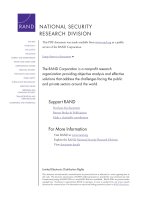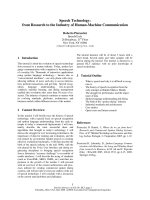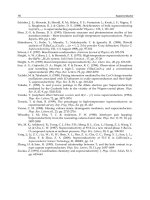From Nuremberg to The Hague - The Future of International Criminal Justice Part 2 doc
Bạn đang xem bản rút gọn của tài liệu. Xem và tải ngay bản đầy đủ của tài liệu tại đây (77.4 KB, 21 trang )
were outmanoeuvred by the American–Soviet alliance
and agreement was reached that Axis leaders should be
tried by a military tribunal for crimes as yet unspecified.
The idea that the trial should be conducted before a mili-
tary court reflected the prevailing convention that war
crimes were a military affair, but in practice the larger
part of the subsequent trial was organised and prose-
cuted by civilian lawyers and judges.
Truman proceeded at once to appoint an American
prosecution team under the leadership of the New Deal
lawyer Robert H. Jackson, who had cut his teeth on
fighting America’s powerful industrial corporations in
the 1930s under Roosevelt’s antitrust legislation.
7
Jackson was the principal architect of the trial and the
decisive figure in holding together an unhappy alliance
of Soviet, British and French jurists, who represented
the only other United Nations states to be allowed to
participate in the tribunal. The Soviet prosecution team
favoured a trial but treated the proceedings as if the
outcome were a foregone conclusion, a show-trial.
French lawyers were unhappy with a tribunal whose
main basis was to be Anglo-Saxon common law instead
of Roman law, and whose procedures were foreign to
French legal practice. Above all, the British accepted the
6
7
NA II, RG 107, McCloy papers, President Truman, Executive
Order 9547, 2 May 1945.
idea of a trial with great reluctance. They remained
sceptical that a proper legal foundation could be found
in existing international law, and doubted the capacity
of the Allied prosecution teams to provide solid forensic
evidence that Axis leaders had indeed committed iden-
tifiable war crimes. British leaders were much more
squeamish than the Americans about sitting side-by-
side with representatives of a Soviet Union whose own
responsibility for aggression and human rights viola-
tions was popular knowledge. The driving force behind
the tribunal was the American prosecution team under
Jackson. Without them, an international war crimes
tribunal might never have been assembled.
The preparation of the tribunal exposed the extent to
which the trial was in effect a ‘political act’rather than an
exercise in law. When the American prosecution team
was appointed in May 1945, there was no clear idea
about who the principal war criminals would be, nor a
precise idea of what charges they might face. A list of
defendants and a list of indictable charges emerged only
after months of argument, and in violation of the tradi-
tions of justice in all the major Allied powers.The choice
of defendants was the product of a great many different
strands of political argument, and was not, as had been
expected,self-evident.Some of those eventually charged
at Nuremberg, like Hitler’s former Economics Minister,
The Nuremberg trials: international law in the making 7
Hjalmar Schacht, were given no indication for six
months that they might find themselves in the dock.
Schacht himself had been taken into Allied custody
straight from a Nazi concentration camp.
8
Quite how arbitrary the choice eventually was can be
demonstrated by a remark made by Britain’s attorney-
general at a meeting in June 1945 to draw up yet
another list of defendants: ‘The test should be: Do we
want the man for making a success of our trial? If yes,
we must have him.’
9
The task of assigning responsibility
was made more difficult by the death or suicide of the
key figures. Hitler killed himself on 30 April 1945;
Heinrich Himmler, head of the SS and the managing-
director of genocide, killed himself in British custody in
May; Joseph Goebbels died with Hitler in the bunker;
Benito Mussolini was executed by partisans shortly
before the end of the war. This last death accelerated the
decision to abandon altogether the idea of putting Axis
leaders in the dock. Italian names had been included on
the early lists of defendants, but by June they had been
removed. Italian war criminals were turned over to the
Italian government for trial. Italy was now a potential
8
8
Imperial War Museum,London,FO 645 Box 154,Foreign Office
Research Department, Schacht personality file; PRO, WO
208/3155, Schacht personality file.
9
PRO, LCO 2/2980, minutes of second meeting of British War
Crimes Executive, 21 June 1945, p. 2.
ally of the West. Other Axis allies, like Admiral Horthy
of Hungary, were also quietly dropped from the list. By
mid-summer all the prosecuting powers had come to
accept that they would try only a selection of German
political and military leaders.
This decision still begged many questions. In 1945,
the international community faced for the very first
time the issue of bringing to trial the government of one
of its renegade members. In theory the entire govern-
mental and military apparatus could be arraigned: if
some were guilty, then, as Robert Ley complained in his
tirade against the legal basis of the trial, all were guilty.
The early American lists did include a hundred names
or more. The British prosecution team, under Sir David
Maxwell Fyfe, favoured a smaller and more manageable
group, and for much of the summer expected to try
only half-a-dozen principal Nazis, including Hermann
Göring, the self-styled ‘second man in the Reich’.At one
point, the British team argued for a single, quick trial
using the portly Göring as symbol for the dictator-
ship.
10
The chief difficulty in drawing up an agreed list
of defendants derived from different interpretations of
the power-structure of the Third Reich. In 1945, the
view was widely held that Hitlerism had been a malign
The Nuremberg trials: international law in the making 9
10
PRO, LCO 2/2980, minutes of third meeting of British War
Crimes Executive, 25 June 1945, pp. 1–4.
extension of the old Prussia of militarism and
economic power. The real villains, on this account, were
to be found among the Junker aristocracy and the
industrial bosses, who were Nazism’s alleged paymas-
ters. Clement Attlee, Churchill’s deputy prime minister,
and then premier himself following Labour’s election
victory in July 1945, argued forcefully that generals and
business leaders should be dragged into the net.
‘Officers who behave like gangsters’, wrote an uncharac-
teristically intemperate Attlee, ‘should be shot.’ He
called for a cull of German businessmen ‘as an example
to the others’.
11
These views did not go uncontested. The indictment
of large numbers of senior officers was regarded as a
dangerous precedent, which might allow even the
defeated enemy the opportunity to argue that Allied
military leaders were just as culpable. The decision to
include German bombing as part of the indictment was
quietly dropped for just such reasons. The issue of
economic criminals was equally tendentious. While
Soviet lawyers, British socialists and Jackson’s team of
New Dealer lawyers saw nothing unjust about including
industrial magnates at Nuremberg, they were opposed
by those who saw business activity as independent of
10
11
PRO, PREM 4/100/10, Deputy Prime Minister, ‘Treatment of
Major Enemy War Criminals’, 26 June 1944.
politics and war-making. Even Albert Speer, Hitler’s
armaments minister and overlord of the war economy,
was argued about. He was, one British official suggested,
‘essentially an administrator’, not a war criminal.
12
This
tendency to see economic leaders as functionaries
rather than perpetrators probably saved Speer from
hanging when the trial ended in 1946.
The many arguments over whom to indict betrayed a
great deal of ignorance and confusion on the Allied side
about the nature of the system they were to put on trial.
Only gradually over the summer, and thanks to a wealth
of intelligence gathering and interrogation, did a clearer
picture emerge. But there still remained significant
gaps. Knowledge of the extent and character of the
Holocaust was limited to information supplied by
Jewish organisations. The chief managers of genocide,
the Gestapo chief, Heinrich Müller, and his deputy,
Adolf Eichmann, were missing from most lists of
potential defendants. Because he made more noise than
the other party fanatics, the prosecution chose Julius
Streicher, editor of the scurrilous anti-semitic journal
Der Stürmer, as the representative of Nazi racism. Yet
Streicher had held no office in the SS racist apparatus,
knew nothing of the details of the Holocaust, and had
The Nuremberg trials: international law in the making 11
12
PRO, LCO 2/2980, British War Crimes Executive meeting, 15
June 1945, p. 2.
lived in disgrace since 1940 after Hitler had sacked him
as Gauleiter of Franconia on corruption charges. Full
interrogation testimony on the Holocaust and its
perpetrators was received only days before the start of
the trial in November 1945, when it at last became clear
that the men the Allies should have been hunting were
still at large.
The final agreed list of twenty-two defendants repre-
sented a series of compromises. The original six British
names were never in question: Göring, the foreign
minister Joachim von Ribbentrop, interior minister
Wilhelm Frick, labour front leader Robert Ley, Ernst
Kaltenbrunner, head of the security apparatus, and the
party’s chief ideologue, Alfred Rosenberg. Other names
were added as representative of important aspects of
the dictatorship. The idea of representation was with-
out question legally dubious, but it resolved many of
the disputes between the Allies over how large the even-
tual trial should be. Streicher stood for anti-semitism;
Hitler’s military chef de cabinet, Wilhelm Keitel, and his
deputy for operations, Alfred Jodl, stood for German
militarism; the unfortunate Schacht and his successor
as economics minister, Walther Funk, were made to
represent German capitalism. Jackson insisted that
Gustav Krupp, the one industrial name well-known
everywhere outside Germany, should also be included,
12
despite his age and his debilitated condition. But he was
too ill to attend,and Jackson’s efforts to extend the prin-
ciple of representation by simply requiring Krupp’s son,
Alfried, to attend in his place was too much for the
other prosecution teams, and the trial went ahead with
no Prussian ‘iron baron’ in the courtroom.
13
Others were included for a variety of reasons. Karl
Dönitz, head of the German navy and Hitler’s brief
successor as chancellor, had his name added at the
Potsdam conference, when it was brought up by the
Soviet Foreign Minister. Only days before, the British
prosecution had warned that the Dönitz case was so
weak that he would probably be acquitted, an outcome
regarded candidly as ‘disastrous to the whole purpose of
the trial’.
14
The Soviet Union did not want to be alone in
presenting none of its Nazi prisoners at Nuremberg,and
in August insisted that Admiral Erich Raeder and an offi-
cial of Goebbels’ propaganda ministry, Hans Fritsche,
should also be included. The remaining group of Nazi
ministers and officials were deemed to have done
The Nuremberg trials: international law in the making 13
13
On Krupp, see Imperial War Museum,FO 645, Box 152, minutes
of meeting of chief prosecutors, 12 November 1945, p. 1.
Jackson’s views on Krupp are in NA II, RG 238, Box 26, draft of
press release.
14
PRO, WO 311/576, British War Crimes Executive to War Office,
20 June 1945; War Office to Supreme Headquarters, Allied
Expeditionary Force (Paris), 27 June 1945.
enough to merit their inclusion, but the final list left out
men like Otto Thierack, the SS minister of the interior
and former head of the Nazi People’s Court, and the SS
general, Kurt Daluege, head of the Order Police and an
important figure in the apparatus of repression and
genocide. Both were in Allied captivity. To ensure that
even these men would eventually stand trial in a series of
subsequent tribunals, the Allied prosecutors,at Jackson’s
prompting, agreed to arraign a number of organisation
as well as individuals. It was hoped that,by declaring the
organisations criminal, further trials of individuals now
classified as prima facie criminals could be speeded up.
This was a device of doubtful legality, since it placed
much of the basis of war crimes trials on retrospective
justice,but nonetheless alongside the twenty-two defen-
dants at Nuremberg stood metaphorically the SS, the SA,
the Gestapo and the rest of the German cabinet and mili-
tary high command.
15
The framing of the charges was a little less arbitrary.
Here there was no precedent at all. The war crimes
defined at the end of the First World War and subject to
common agreement included crimes that had evidently
been perpetrated by the Nazi system:‘systematic terror-
ism’, ‘torture of civilians’, ‘usurpation of sovereignty’
14
15
NA II, RG 238, Box 34, Indictment first draft, p. 1.
and so on.
16
The difficulty in this case was to define
crimes in terms that could be applied to the men in the
dock, few of whom could be shown beyond any reason-
able doubt to have directly ordered or perpetrated
particular crimes, even if they served a criminal regime.
The main charge was deemed to be the waging of
aggressive war as such, but this had never been defined
as a crime in international law, even if its prosecution
might give rise to specific criminal acts. War was
regarded as legally neutral, in which both sides enjoyed
the same rights, even in cases of naked aggression. To
define the war-making acts of the Nazi government as
crimes required international law to be written back-
wards. Even more problematic was the hope that the
crimes perpetrated against the German people by the
dictatorship, and the persecution and extermination of
peoples on grounds of race, could also be included in
any final indictment. This violated the principle in
international law that the internal affairs of a sovereign
state were its own business, however unjustly they
might be conducted. Here, too, legal innovation was a
pre-condition for trial.
The radical solution proposed by Jackson and the
American prosecution team was to include all the
The Nuremberg trials: international law in the making 15
16
NA II, RG 107, McCloy papers, Box 1, United Nations War
Crimes Commission memorandum, 6 October 1944, Annex A.
actions deemed to be criminal under the single heading
of a conspiracy to wage aggressive and criminal war.
This tautological device was first thought up in
November 1944 by an American military lawyer,
Murray Bernays. It had obvious merits beyond that of
simplicity. Bernays concluded that a conspiracy to wage
aggressive war could rightfully include everything the
regime had done since coming to power on 30 January
1933. It could include the deliberate repression of the
German people, the plans for rearmament, the persecu-
tion of religious and racial minorities, as well as the
numerous crimes committed as a consequence of the
launching of aggressive war in 1939.Moreover,conspir-
acy removed the central legal problem that defendants
could claim obedience to higher orders in their defence,
or that Hitler (who at that point was still alive, and
expected to be the chief defendant) could claim immu-
nity as sovereign head of state. Conspiracy caught
everyone in the net, regardless of their actual responsi-
bility for specific acts.
17
The idea of conspiracy remained the essence of the
American prosecution case right through to the trial
16
17
NA II, RG 107, Stimson papers, memorandum on war crimes, 9
October 1944; letter from Stimson to Stettinius (Secretary of
State), 27 October 1944, enclosing ‘Trial of European War
Criminals: The General Problem’, pp. 1–5.
itself. In May 1945, the American War Department drew
up a memorandum for Jackson setting out the case that
the major war criminals collectively ‘entered into a
common plan or enterprise aimed at the establishment
of complete domination of Europe and eventually
the world’.
18
In June, Jackson reported to President
Truman his belief that the German leadership had
indeed operated with a ‘master plan’,in which everything
from the indoctrination of German youth to the
muzzling of the trade unions had served the central
grotesque ambition to wage criminal war on the world.
19
The conspiracy charge neatly removed the need to define
new categories of crime for the other policies pursued by
the regime, since they could, Jackson believed, all be
subsumed under the heading of the master plan.
The conspiracy thesis provoked both scepticism and
unease among the other prosecution teams. The first
problem was simply one of evidence. The central docu-
ment in the American case was Hitler’s Mein Kampf,
which was naively considered to be an outline of the
future foreign policy of Hitler’s Germany. A British
Foreign Office analysis of the content of the book, writ-
The Nuremberg trials: international law in the making 17
18
NA II, RG 107, McCloy papers, Box 3, draft Planning
Memorandum, 13 May 1945, p. 2.
19
NA II, RG 107, Stimson papers, Box 5, Bernays to Stimson,
report to the President, 7 June 1945.
ten in June 1945, was forced to conclude that the book
‘does not reveal the Nazi aims of conquest and domina-
tion fully and explicitly’.
20
The British argued that the
Nazis were‘supreme opportunists’,and thought it highly
unlikely that the prosecution could make a conspiracy
theory work,not only in law,but in terms of the available
evidence. The second problem was the absence of any
legal foundation for the charge of conspiring to wage
aggressive war. Jackson insisted that such a foundation
existed in the Kellogg–Briand Pact signed in Paris in
1928 by sixty-five signatory powers.The Pact was a state-
ment of intent rather than a binding international
convention,but the intent was clear enough: to renounce
war as a means of settling disputes, except in the case of
self-defence. It was signed by Germany, Japan, Italy and
the Soviet Union,all of whom undertook wars of aggres-
sion at some point in the decade that followed. Its
American sponsors declared that signature of the Pact
heralded ‘the outlawry of war’; this interpretation
sustained Jackson’s later argument that,under its terms,
‘aggressive war-making is illegal and criminal’.
21
18
20
PRO, LCO 2/2900, Foreign Office memorandum, ‘Nazism as a
Conspiracy for the Domination of Europe’, 22 June 1945, pp.
1–2.
21
NA II, RG 107, report to the President, 7 June 1945, pp. 6–7. See
also J. P. Kenny, Moral Aspects of Nuremberg (Washington DC,
1949), p. 6.
There were problems too with the French and Soviet
approach to the trials. In neither state did the legal
tradition support the idea of conspiracy. Whereas in
Anglo-Saxon law it was possible to declare all those
complicit with a conspiracy as equally responsible in
law, in French and Soviet (and German) law the
defendant had to be charged with a specific crime in
which he had directly participated. The French
preferred a trial based on particular atrocities and acts
of terrorism, but this would have prevented the
prosecution of most of those who ended up in the dock
at Nuremberg. The Soviet legal experts, who had first
invented the term ‘crimes against peace’, used later in
the Indictment, were very concerned that ‘conspiracy to
wage aggressive war’should be confined only to the Axis
states, and only to specific instances of violation:
Poland in 1939, the Soviet Union in 1941, and so on.
This anxiety masked more than legal niceties. If Jackson
succeeded in making the waging of aggressive war into a
substantive crime in international law, then the Soviet
Union was equally guilty in its attacks on Poland in
September 1939 and on Finland three months later.
Jackson knew this. In his personal file on ‘Aggression’
were the terms of the German–Soviet agreement of
1939, dividing Poland. It was kept in the file and never
presented at Nuremberg. The Soviet authorities
The Nuremberg trials: international law in the making 19
ordered any discussion of aggression against Poland
removed from the opening address of the Soviet
prosecutor, and the Soviet courtroom team was under
specific instructions to shout down any attempt by the
defendants to raise awkward issues of Soviet–German
collaboration.
22
The result of these many objections was a compro-
mise. Jackson agreed that the charge of conspiracy
should only apply to specific acts of Axis aggression,
and that other charges should be brought separately,
not simply placed under the umbrella of a general
conspiracy. But this still left the difficulty of how to
include the terror and racism of the regime in any
indictment. None of the prosecution teams wanted to
focus only on the waging of war, and the crimes that
resulted directly from it. In particular, the American
and British prosecutors wanted to include Nazi anti-
semitism as an indictable offence. The difficulty in
doing so was highlighted when an academic judgment
was sought on how to define Nazi racial and national
persecution in law. Rafael Lemkin coined a new term
‘genocide’ to describe the intention to ‘cripple in their
20
22
NA II, RG 238, Box 32, aggression file. See also S. Mironenko,‘La
collection des documents sur le procès de Nuremberg dans les
archives d’état de la fédération russe’, in A. Wiewiorka (ed.), Les
procès de Nuremberg et de Tokyo (Paris, 1996), pp. 65–6.
development, or destroy completely, entire nations’, but
he concluded that this could not apply to the Jews, who
were not a nation, and he omitted anti-semitism in his
suggested list of cases in which ‘genocide’ had
occurred.
23
Since both the French and Soviet prosecu-
tors were anxious to include the persecution of their
populations in the trial proceedings, a new category of
offence, ‘crimes against humanity’, was agreed. Under
the terms of these crimes could be included the deliber-
ate persecution and murder of Jews, gypsies and Poles.
The most powerful legal objection was never prop-
erly confronted. The crimes of which the defendants
stood accused were not regarded as crimes when they
were committed, with the exception of war crimes as
defined under international agreement. Robert Ley
began his rejection of the legal basis of the tribunal by
pointing out that the declaration establishing the
Tribunal, issued on 8 August 1945, created laws ‘after all
the crimes mentioned in the indictment, which they
wish to judge, had been committed’.
24
The idea of retro-
spective justice was foreign to most legal traditions. The
idea that the Tribunal would be both legislator and
judge, creating crimes in order to punish them, was
The Nuremberg trials: international law in the making 21
23
NA II, RG 238, Judge Advocate’s papers, memorandum for
General John Weir from Rafael Lemkin, 14 July 1945, pp. 3–14.
24
NA II, RG 238, Jackson main files, Box 3, Ley to Pflücker, p. 1.
something that Western legal opinion also found diffi-
cult to accept. When the Acting Dean of the Harvard
Law School was asked for an opinion on the conspiracy
charge, he argued that retrospective justice was alien to
the spirit of ‘Anglo-American legal thought’, and urged
its rejection as ‘unwise and unjustifiable’.
25
The
Professor of International Law at London University,H.
A. Smith, writing in December 1945, argued that the
Tribunal was to be treated as a ‘special case’, which self-
consciously departed from the principle ‘that a man
must not be punished for an act which did not consti-
tute a crime at the time when it was committed’. Only
time would show whether this ‘very serious’ decision
was ‘right or wrong’.
26
Jackson was quite aware of these objections. When he
prepared his first report on the plans for a trial for
Truman in June 1945, he argued that, even if they were
not designated crimes, the acts committed by the Axis
enemy ‘have been regarded as criminal since the time of
Cain’.
27
The argument in favour of retrospective justice
rested on the idea that many of the acts covered by the
22
25
NA II, RG 107, McCloy papers, Box 3, ‘Morgan’s Opinion on
Conspiracy Theory’, 12 January 1945, pp. 2–4.
26
H. A.Smith,‘The Great Experiment at Nuremberg’,The Listener,
vol. 34, 13 December 1945, p. 694.
27
NA II, RG 107, Stimson papers, Box 5, Bernays to Stimson, 7
June 1945, pp. 4–5.
Indictment were in fact known to be criminal at the
time they were committed, and would have been
subject to criminal proceedings had the law not been
perverted by dictatorship. These were flimsy argu-
ments, but the central purpose of the Tribunal was not
to conform to existing principles in international law
but to establish new rules of international conduct and
agreed boundaries in the violation of human rights.
The Indictment formally issued on 19 October 1945
consisted of four charges: a common conspiracy to
wage aggressive war; crimes against peace; war crimes;
and crimes against humanity. At least one of the four
prosecuting states,the Soviet Union, was guilty on three
of the four counts for acts it had wilfully committed on
its own behalf during the previous decade.
The conduct of the trial betrayed the improvised and
ambiguous character of its origin. There were practical
issues that had not been anticipated. The time taken to
translate documents in evidence and other trial ma-
terial into French and Russian meant that the prosecu-
tion teams often lacked the papers they needed, or
received them at the last moment. Defence lawyers had
particular difficulty in obtaining access to material
necessary for the presentation of their defence. All the
prosecution teams were short of skilled translators and
interpreters, which compounded the problem. The
The Nuremberg trials: international law in the making 23
sheer volume of accumulated evidence made it certain
that the trial would take considerably longer than had at
first been intended. In the summer of 1945, it was
hoped that a trial could be started in September and
might be over by Christmas. A speedy trial was felt to be
desirable to satisfy Allied public opinion that justice was
being done as swiftly as judicial process would allow.
28
In reality, the trial lasted for almost a year, and it proved
difficult to sustain popular interest in its outcome.
It was also difficult to mask the extent to which the trial
was governed by political as much as by legal considera-
tions. The Soviet authorities made no pretence that they
considered all the defendants guilty a priori.The trial was
regarded as a show-trial, in which Nazi leaders would be
exposed to public disapproval before execution. Stalin
established a government commission ‘on the direction
of the Nuremberg trial’, which oversaw efforts to ensure
that nothing hostile to Soviet interests would be exposed
by the court. In November 1945,the NKVD sent Colonel
Likhachev to Nuremberg to win the support of the other
three prosecution teams in avoiding awkward questions
about Soviet foreign policy.
29
The other powers tolerated
24
28
PRO, FO 1019/82, Maxwell Fyfe to Jackson, 21 Sept
ember 1945,
p. 2.
29
A. Vaksberg, The Prosecutor and the Prey: Vyshinsky and the
1930s Moscow Show Trials (London, 1990), pp. 258–9.
the pressure, though in the notorious case of the Katyn
massacre of Polish soldiers the British authorities were,
rightly, convinced that this had been a Soviet, not a Nazi
atrocity. At one point during the trial, the Soviet
Procurator-General, Andrei Vyshinsky, guest-of-honour
at a dinner for the Tribunal judges, compelled his
companions to raise their glasses in a macabre toast to the
defendants:‘May their paths lead straight from the court-
house to the grave!’
30
This was a difficult position for
American and British judges, who could scarcely endorse
the imminent execution of men they were supposed to be
treating with judicial impartiality.
Nonetheless, the three Western powers all came to
accept the Soviet position that Allied actions which
might now be regarded as crimes as a result of the new
categories defined by the Tribunal should be excluded
from review. Throughout the trial there was only one
brief mention of the Soviet–Finnish war, and this was
shouted down. Bombing was not included as a war
crime, despite the fact that large numbers of innocent
civilians were killed on both sides. Even while the
horrors of the Nazi camp system were being revealed in
court, the Soviet authorities were setting up concentra-
tion camps in the Soviet zone of occupation, like the
The Nuremberg trials: international law in the making 25
30
T. Taylor, The Anatomy of the Nuremberg Trials: A Personal
Memoir (London, 1993), p. 211.
isolation camp at Mühlberg on the Elbe, where, out of
122,000 prisoners who were sent without trial to the
camp, over 43,000 were killed or died.
31
This collaboration was sustained in the face of the
emerging Cold War for several reasons. It was impor-
tant for the Western states that the trial did not break
down into inter-Allied bickering, and that the Soviet
Union was not exposed as an international criminal.
The hypocrisy was sustained on grounds of Realpolitik.
The whole purpose of the trial, as a statement about
international morality and human rights, would have
been destroyed, and Nazi crimes viewed with an
unwanted moral relativism, if the situation had been
otherwise. The political purpose of the trials was also
evident in the efforts to use them as part of a more
general programme of re-education in Germany, and,
by implication, in the rest of Europe. In one of the pre-
trial interrogations, the American interrogator,Howard
Brundage, explained to his interviewee, the diplomat
Fritz Wiedemann, what he believed the trials repre-
sented:
We are trying to get up a record here for the benefit
of the children of Germany, so that, when another
time comes and a gang like this gets control of the
26
31
A. Kilian, Einzuweisen zur völligen Isolierung. NKWD-
Speziallager Mühlberg/Elbe 1945–1948 (Leipzig, 1993), p. 7.









